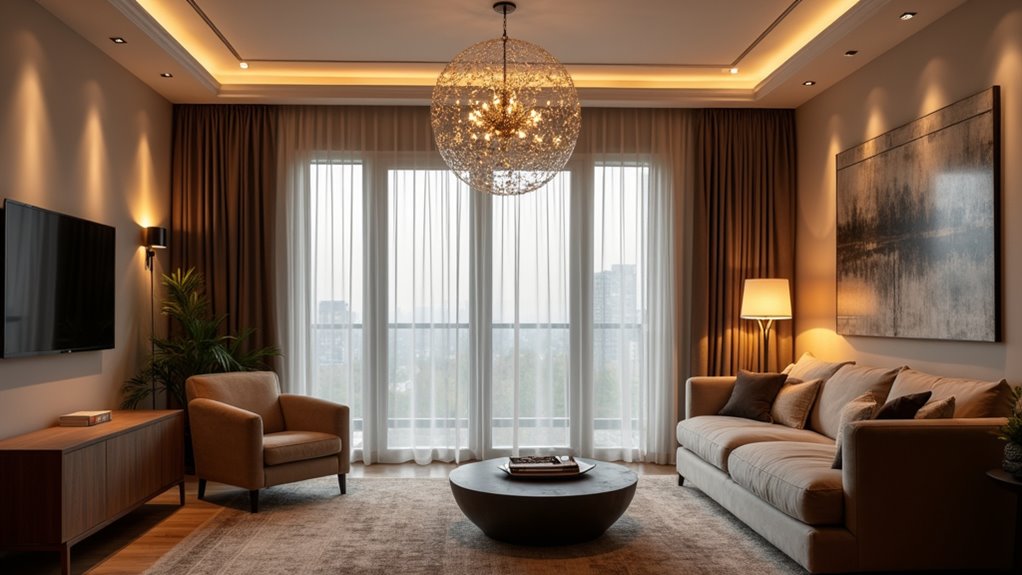Crafting perfect living room lighting requires strategic design. Layer ambient, task, and accent lights for depth. Select fixtures matching decor, ensuring style and function. Install dimmers to tailor ambiance with precision. Maximize natural light using sheer curtains and reflective surfaces. Choose LEDs (2400K-3000K) for warm, efficient glow. Design around activity zones like reading corners for targeted illumination. Position lights to avoid glare and enhance balance. Explore further to uncover deeper insights into transformative lighting techniques.
Key Takeaways
- Layer ambient, task, and accent lighting for depth and versatility in your living room.
- Use dimmers to customize ambiance and save energy effortlessly.
- Position lights strategically to highlight focal points and prevent glare.
- Harness natural light with reflective surfaces and light color palettes.
- Choose LED bulbs for warmth, efficiency, and long-lasting illumination.
Layer Your Lighting for Depth and Versatility
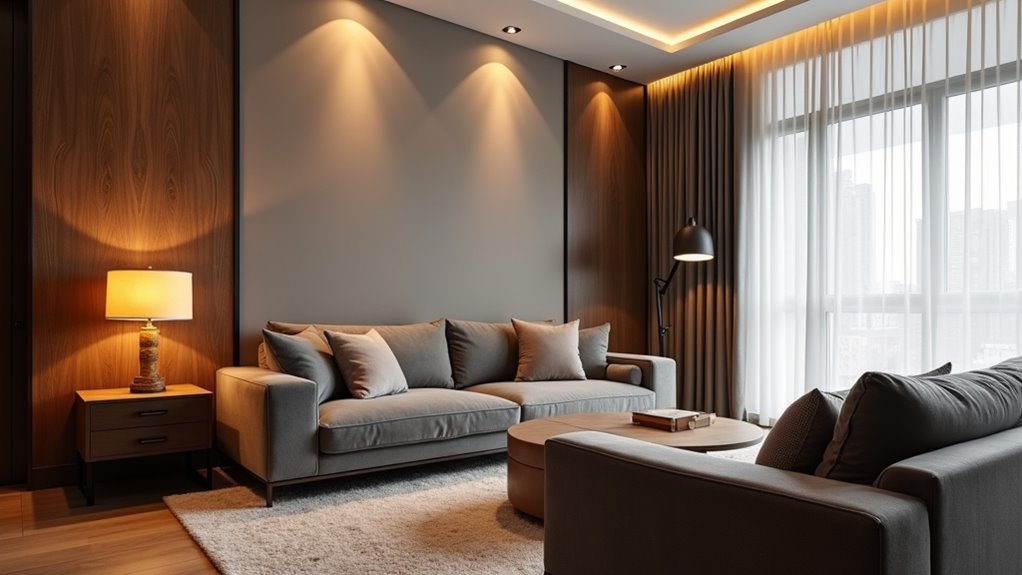
In the realm of interior design, layering lighting stands as a pivotal technique for crafting a living room that is both functional and visually captivating. Light layering involves the strategic integration of ambient, task, and accent lighting to create depth and versatility.
Ambient light sets a foundational glow, often with a warm color temperature to foster an inviting atmosphere, while task lighting delivers focused illumination for activities like reading, ensuring precision without strain.
Accent lighting, meanwhile, highlights architectural features or decor, adding drama through contrast. By incorporating dimmers, you can easily adjust the intensity of each layer to suit different moods or occasions with seamless control.
This meticulous approach to light layering transforms a space by balancing brightness and shadow, sculpting dimension at varying heights and angles. It enables adaptability, allowing the room to shift from bright, energizing settings to soft, relaxing moods. Additionally, this method promotes energy efficiency by allowing targeted illumination and reducing unnecessary power usage.
Select Fixtures Strategically for Style and Function
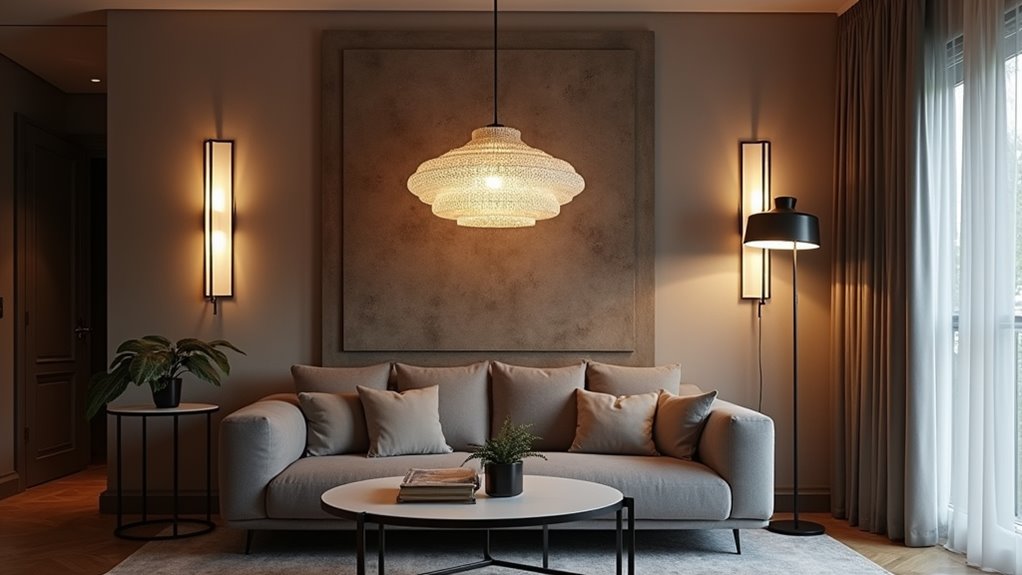
How does one elevate a living room beyond mere illumination to a seamless blend of style and purpose? The answer lies in selecting fixtures that harmonize function with aesthetic appeal. By defining the room’s primary activities—be it reading, entertaining, or relaxing—one can choose task lighting for focused areas and ambient options for overall warmth.
Fixture placement is critical; ceiling-mounted chandeliers offer broad illumination, while wall sconces accentuate features, and floor lamps provide targeted light.
Equally vital is design consistency, ensuring fixtures align with the room’s decor, whether modern with sleek metallics or rustic with wrought iron. Scale matters—oversized pendants suit grand spaces, while flush mounts fit compact rooms. Coordinating finishes like brushed gold or matte black, alongside materials such as glass or wood, ties the look together.
Strategic choices in style, size, and placement transform a living room into a masterpiece of light and design.
Use Dimmers to Customize Ambiance
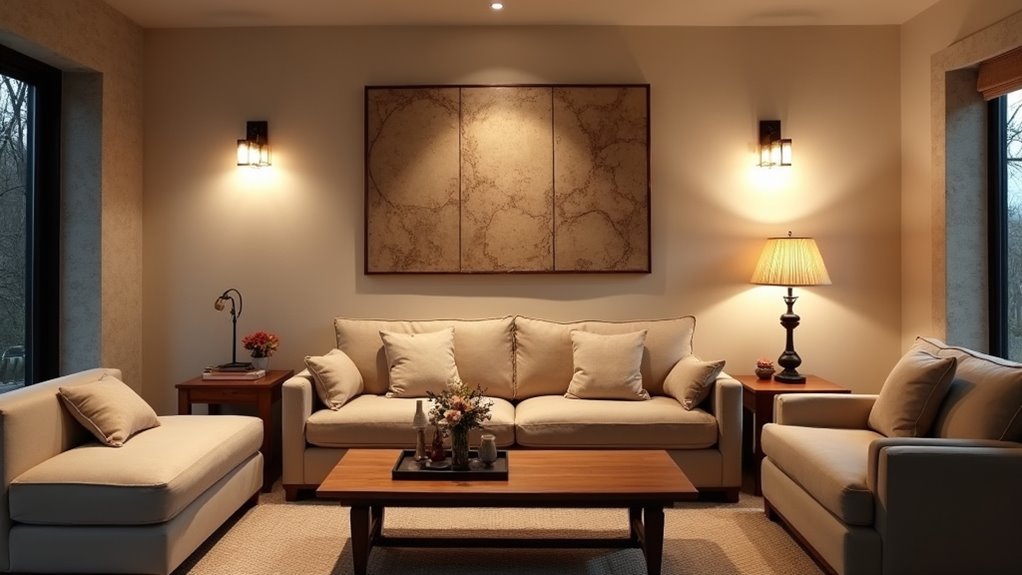
Dimmers offer a sophisticated means to fine-tune the living room’s atmosphere, allowing occupants to shift light intensity from vibrant clarity to a subdued glow with meticulous control.
This flexibility in mood adjustment not only caters to diverse activities but also transforms the room’s emotional impact through nuanced illumination settings.
Additionally, by reducing brightness levels, dimmers contribute to significant energy savings, lowering consumption and extending the efficiency of lighting systems with technical precision.
Enhancing Mood Flexibility
Often, the atmosphere of a living room hinges on the subtle art of lighting control. With dimmers, one can master mood control, fine-tuning color intensity to craft the perfect ambiance for any occasion.
This technical precision transforms a space from vibrant to serene with a simple adjustment.
Dimmers offer versatile solutions, such as:
- Romantic Settings: Lowering light to a soft, warm glow for intimate evenings.
- Lively Gatherings: Increasing brightness to energize social interactions.
- Relaxing Retreats: Dimming to a calming level for unwinding after a long day.
Saving Energy Efficiently
Why settle for static illumination when dimmers offer a dynamic solution to both ambiance and energy efficiency? These ingenious devices, leveraging a Triac switch, rapidly cycle power up to 120 times per second, slashing electricity use by 4-9% even at peak settings.
Dimming by just 25% can save up to 20% energy, while extending bulb life—incandescent and halogen bulbs last up to 20 times longer.
Modern dimmers, paired with smart technology, elevate efficiency further. Integrated with occupancy sensors, they adjust light based on presence, ensuring no watt is wasted. Smart systems also enable remote control and scheduling, optimizing energy use.
This fusion of precision and innovation crafts a sustainable, tailored glow for any living room.
Harness Natural Light for a Bright Space
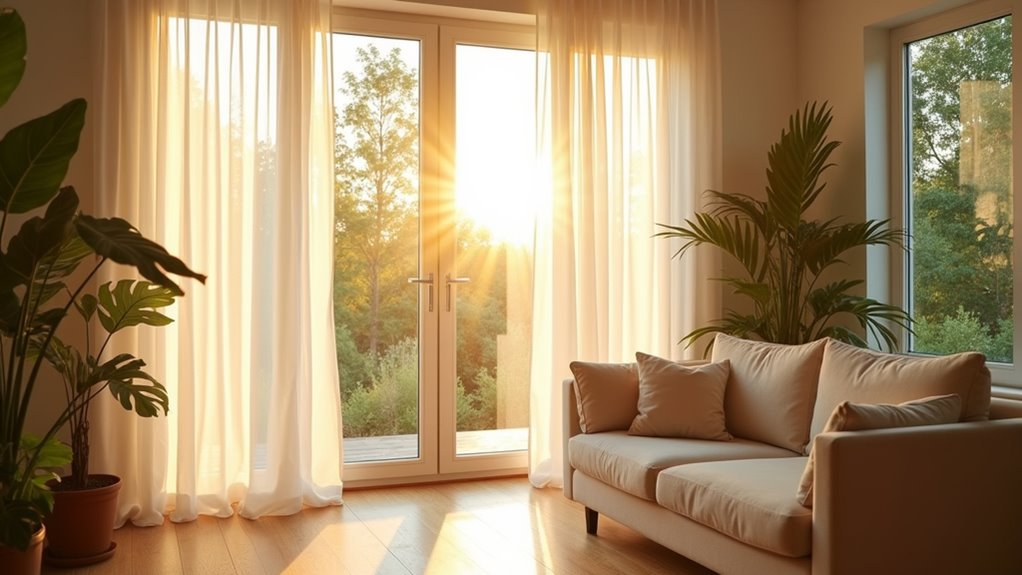
Crafting a living room that radiates brightness begins with harnessing natural light through strategic design choices. Emphasizing natural illumination transforms spaces, making them feel airy and vibrant.
A key aspect, window enhancement, involves selecting treatments like sheer curtains or solar shades to filter sunlight while reducing glare. This ensures a soft, inviting glow.
To maximize this effect, consider these technical yet creative approaches:
- Reflective Surfaces: Position mirrors opposite windows to amplify light, while incorporating glossy finishes or glass tabletops allows light to permeate the room effortlessly.
- Light Color Palette: Opt for walls and ceilings in pale hues with high Light Reflectance Value (LRV), paired with light flooring, to enhance brightness.
- Furniture Placement: Arrange slimline furniture perpendicular to windows, avoiding bulky pieces that cast shadows, to maintain an unobstructed light flow.
Such meticulous strategies ensure a living room remains luminous and welcoming throughout the day.
Pick the Best Bulbs for Warmth and Efficiency
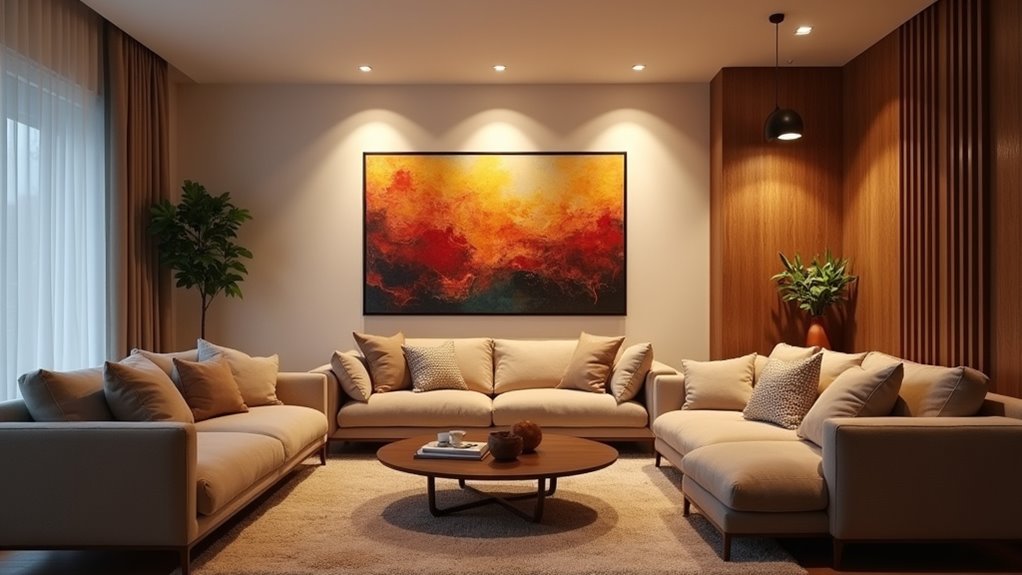
Several critical factors come into play when selecting bulbs for a living room, where the balance of warmth and efficiency can define the space’s ambiance and functionality.
Color temperature, measured in Kelvin, is pivotal; a range of 2400K to 3000K delivers a warm white glow, crafting a cozy, inviting atmosphere akin to a sunset’s embrace.
LEDs stand out with exceptional efficiency, consuming up to 90% less energy than incandescent bulbs, and boast impressive bulb longevity, lasting 25,000 to 50,000 hours.
CFLs, while efficient, lag behind with 6,000 to 15,000 hours, and halogens offer merely 1,000 to 2,000 hours despite their warm tones.
Smart bulbs, often LED-based, provide customizable color temperature settings for tailored warmth.
Incandescents, though naturally warm, falter with a brief 700 to 1,000-hour lifespan and poor efficiency.
Prioritizing LEDs ensures a harmonious blend of enduring performance and comforting illumination for any living room.
Design Lighting Around Activities and Zones
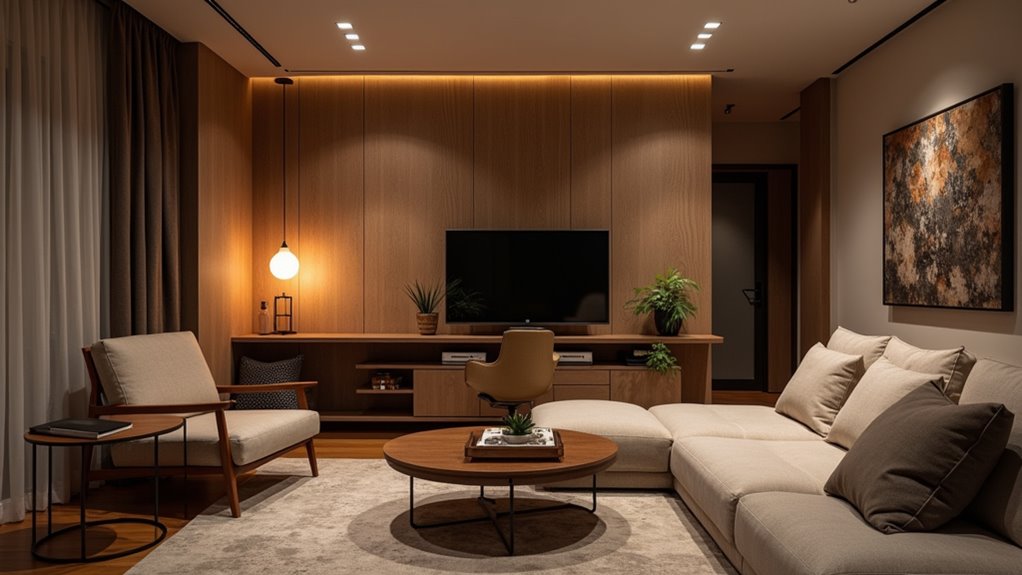
Crafting a well-lit living room begins with a meticulous approach to defining activity areas, ensuring each space is mapped with precision through a detailed floor plan that highlights furniture and architectural nuances.
Lighting must then be tailored to these zones, employing a strategic mix of ambient, task, and accent sources to meet the unique demands of reading nooks, social hubs, or entertainment corners.
This customized integration not only enhances functionality but also weaves a cohesive aesthetic across the room’s multifaceted uses.
Define Activity Areas
Often, the foundation of exceptional living room light design lies in meticulously defining activity areas to ensure both functionality and aesthetic harmony. By identifying key zones for reading, socializing, or working, one can tailor illumination to specific needs. Mapping these on a floor plan, considering furniture placement and traffic patterns, ensures precise light positioning.
Decorative fixtures enhance ambiance, while accounting for ceiling heights optimizes light distribution.
Strategic planning can be broken down into key steps:
- List Activities: Catalog all living room functions to pinpoint lighting requirements.
- Map Furniture: Align lighting with sofas or desks to support tasks.
- Assess Flow: Ensure light aids safe navigation through traffic patterns.
This detailed zoning creates a balanced, inviting space with purposeful illumination.
Customize Lighting Solutions
A well-designed living room thrives on customized lighting solutions that cater to the unique demands of each activity zone. For reading nooks, adjustable floor lamps with focused task lighting eliminate ambient shadows, ensuring clarity.
Socializing areas benefit from dimmable pendant lights and wall sconces, crafting an inviting atmosphere with warm color temperature settings.
TV zones require subtle backlighting via LED strips to avoid glare. Meanwhile, accent track lighting highlights artwork with precision.
Smart lighting systems, integrating dimmers and color-changing bulbs, allow seamless transitions between cool and warm tones for varied moods.
Position Lights Thoughtfully for Balance and Impact
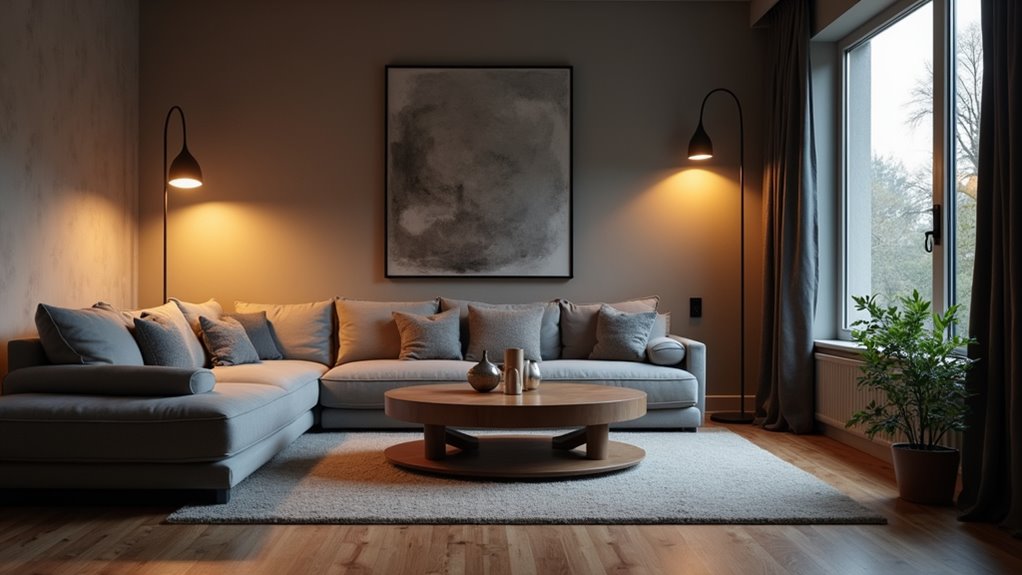
Designing a living room with thoughtful light positioning is essential to achieve both balance and impact in the space. Strategic placement can transform the room’s depth, highlight focal points, and ensure functionality.
By layering ambient, task, and accent lighting, one can create a harmonious environment where each element serves a purpose, from general illumination to spotlighting decor.
Consider these precise strategies for impactful light positioning:
- Angle Downlights: Direct downlights towards curtains or features to reflect light, enhancing spatial perception and warmth.
- Use Uplighting: Place uplights in corners to add dramatic height and soften harsh edges with diffused glow.
- Avoid Glare: Position lights to prevent shadows or glare on screens, ensuring comfort during varied activities.
Such meticulous planning around furniture layout and room function defines zones, fosters safe navigation, and crafts an inviting atmosphere with technical finesse and creative flair.
